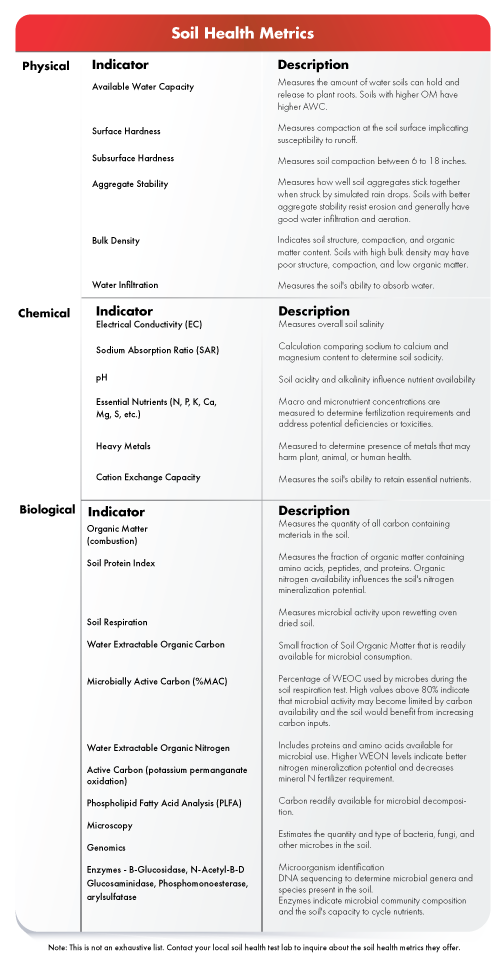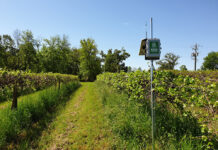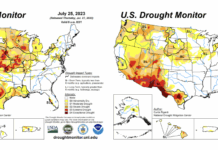Commercial farms throughout the U.S. consistently turn out impressive yields, supplying the nation and the world with quality fruits, vegetables and staple grains. However, every year we lose organic matter and watch topsoil erode with wind and runoff. Heavy tillage, powerful biocides and mineral fertilizers support high production even on suboptimal ground. Safer crop protection products and efficient fertigation practices significantly contribute to extending the longevity of America’s agricultural lands, yet growers still struggle to maintain yields on tired, disease ridden and salt affected soils. Tillage, poor water quality, drought and soil borne disease slowly degrade soil health. Growers must invest in more water, fertilizer and pesticides to maintain their yields and crop quality on declining ground.
Organic Matter and Regenerative Practices
Healthy soils are well aerated, have good water and nutrient holding capacity, have little to no disease pressure and house beneficial microbial ecosystems. Each positive attribute relies on soil organic matter. Annual net carbon loss drives soil degradation and threatens our country’s food security. Tillage is one of the main practices contributing to organic matter loss. Turning the soil introduces an influx of oxygen, temporarily accelerating microbial activity. Bacteria and fungi, no longer limited by O2 availability, rapidly feed on organic matter, releasing carbon dioxide to the atmosphere as they respire. Tillage increases soil carbon loss beyond annual carbon gain. Reducing tillage, or converting to a no-till system, can reverse carbon loss and begin rebuilding soil organic matter. Other practices, such as cover cropping, intercropping and composting, also contribute to carbon sequestration. Specialized agronomists can assist growers in transitioning to a suite of practices to begin rebuilding soil.
No-till cover cropped systems represent the gold standard for carbon sequestration and soil health, yet logistical and economic factors prevent many growers from adopting regenerative practices. When cover cropping and no till are unfeasible, growers can support healthy microbial communities by applying carbon rich liquid amendments and biostimulants. Many organic fertilizers and amendments contain high levels of carbon, amino acids and metabolites to support beneficial microbial activity during crop growth. Carbon-rich fertilizers made from food scraps feed the soil microbiome while providing a societal benefit by diverting waste from landfills. Liquid organic fertilizers, compost and other amendments can improve soil fertility, mitigate salinity and enhance the crop’s stress tolerance. No matter where your farm lies on the sustainability spectrum, you can monitor and manage the land to improve its long-term production capacity.
Soil Health Metrics
Soil health testing can guide management decisions and gauge progress after implementing new practices. Many commercial and university labs provide soil quality panels to assess a wide array of metrics influencing the soil’s production capacity and environmental impact. Some labs offer soil health assessment frameworks that rate soil health based on results for several key indicators. Lab test results for each indicator are mathematically transformed into unitless scores reflecting the level of functionality. Scores for each indicator are combined to give an overall soil health rating. Widely respected soil health frameworks include the Cornell Soil Health Assessment, the Soil Management Assessment Framework (Andrews et al., 2004) and the Haney Test provided by Ward Laboratories.
Metrics included in the assessments vary between labs, but they all aim to include physical, chemical and biological components. Familiar measurements including pH, electrical conductivity (EC) and essential nutrients appear on soil health panels as do traditional field evaluations like water infiltration and wet aggregate stability.
Biological indicators include combustible soil organic matter, water soluble organic carbon and soil respiration. Several biological indicators must be viewed together to accurately interpret field conditions. For instance, increased microbial respiration does not always indicate improved soil health. High respiration rates combined with high organic matter likely indicate good soil health, but when the soil shows high respiration and low organic matter, the microbes may be burning soil carbon faster than it can be captured. Respiration that outpaces carbon sequestration leads to organic matter loss and soil degradation.
Advances in Biological Testing
Other biological metrics provide insight into nutrient cycling, disease pressure and crop stress tolerance. Enzyme analysis indicates the microbial community’s capacity to mineralize N, P, K and micronutrients. Pathologists can diagnose fungal, bacterial, nematode and viral pathogens so that growers can choose the right fumigants and crop rotations to keep disease pressure in check.
Phospholipid Fatty Acid Analysis (PLFA) helps determine the abundance and types of microbes in the soil. Identifying some of the beneficial microbes helps us predict the soil’s ability to inhibit disease, enhance crop growth and increase nutrient availability. Recent advances in genomics offer exciting opportunities to sequence all the DNA found in a soil sample and map microbial community composition and functioning. Genomics offer a more comprehensive analysis of microbial community than PLFA can provide. Tracking shifts in the microbiome may help determine how land management influences the soil’s trajectory towards improved sustainability.
Choosing Soil Health Indicators
Healthy soils share many common characteristics, but growers may prioritize some attributes over others depending on their needs. Growers can select soil health indicators relevant to their unique goals, production system, climate and soil type. Farmers converting to no-till can monitor progress by measuring organic matter. Those who continue tilling but begin cover cropping may not observe significant OM increases, but they might find decreased compaction and improved soil aggregate stability. Biostimulant and organic amendment efficacy may be measured by analyzing enzymatic activity and changes in the soil microbiome.
Soil health tests are accessible, affordable and offer practical insights into how farming practices affect the soil’s long term production capability. Track progress by annually measuring soil health indicators most likely to change according to the management practices implemented. Every farm can contribute to agricultural sustainability by adopting simple practices like applying carbon-based amendments or launching advanced regenerative programs such as no-till and intercropping. Soil health can also improve by knocking out disease pressure with soil fumigation and allowing beneficials to repopulate. Soil health tests can guide management decisions at every level to ensure that your effort and investment brings in quality crops every year.
Eryn Wingate is an agronomist with Tri-Tech Ag Products, Inc. in Ventura County, California. Eryn provides soil health and nutrient management consulting services to support quality crop production while meeting sustainability and environmental protection goals.
Citations & Resources
Andrews, S.S., Karlen, D.L., and Cambardella, C.A. 2004. The soil management assessment framework: a quantitative soil quality evaluation method. Soil Science Society of America Journal 68: 1945-1962.
Moebius-Clune, B.N. et al. 2016. Comprehensive Assessment of Soil Health – The Cornell Framework Manual, Edition 3.1, Cornell University, Geneva, NY.
Soil Health Institute – North American Project to Evaluate Soil Health Indicators: soilhealthinstitute.org/north-american-project-to-evaluate-soil-health-measurements/
Natural Resources Conservation District Soil Health Assessment Resources: nrcs.usda.gov/wps/portal/nrcs/detail/soils/health/assessment/?cid=stelprdb1237387
Ward Laboratories Haney Test Information: wardlab.com/haney-test/




















